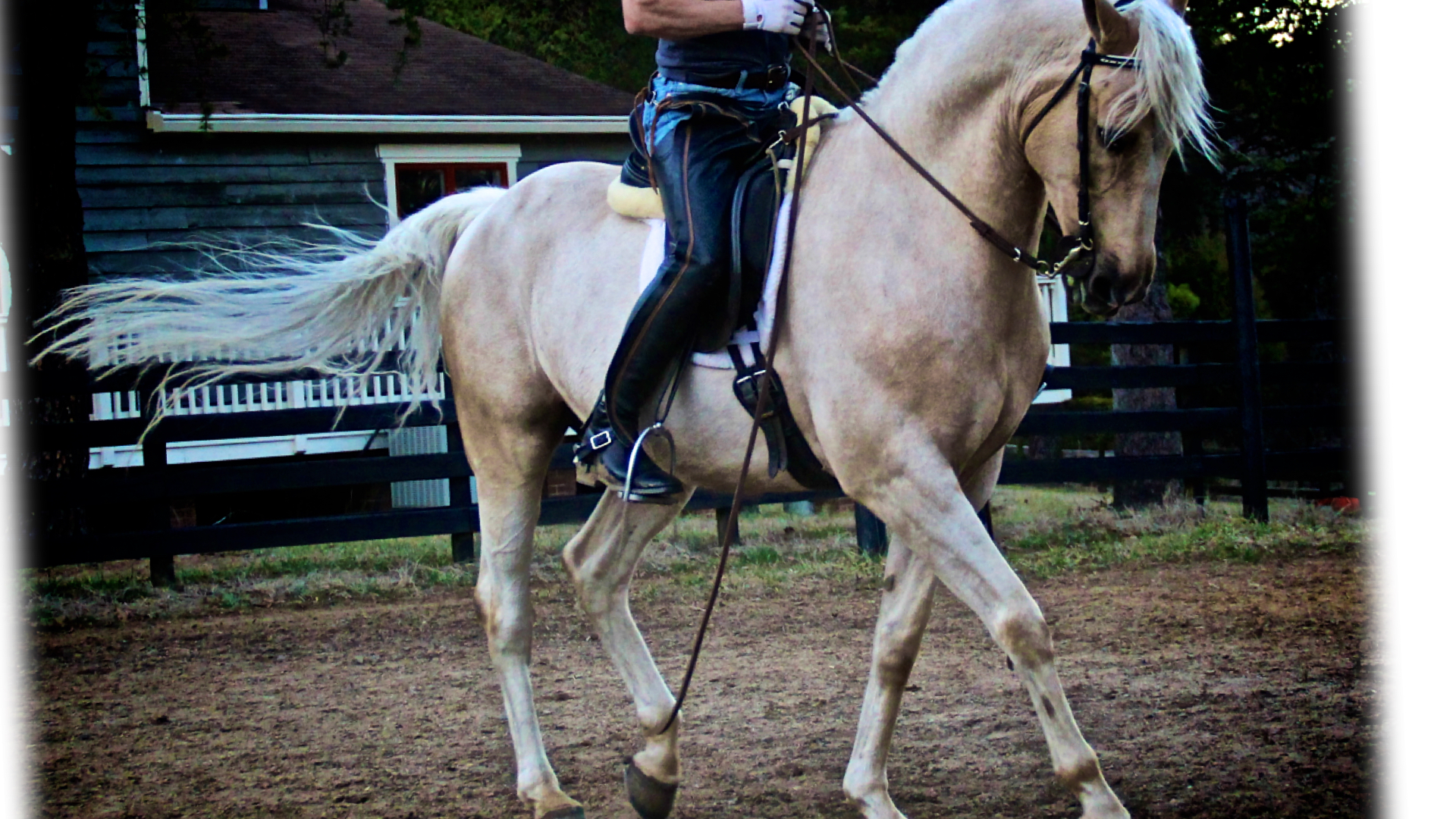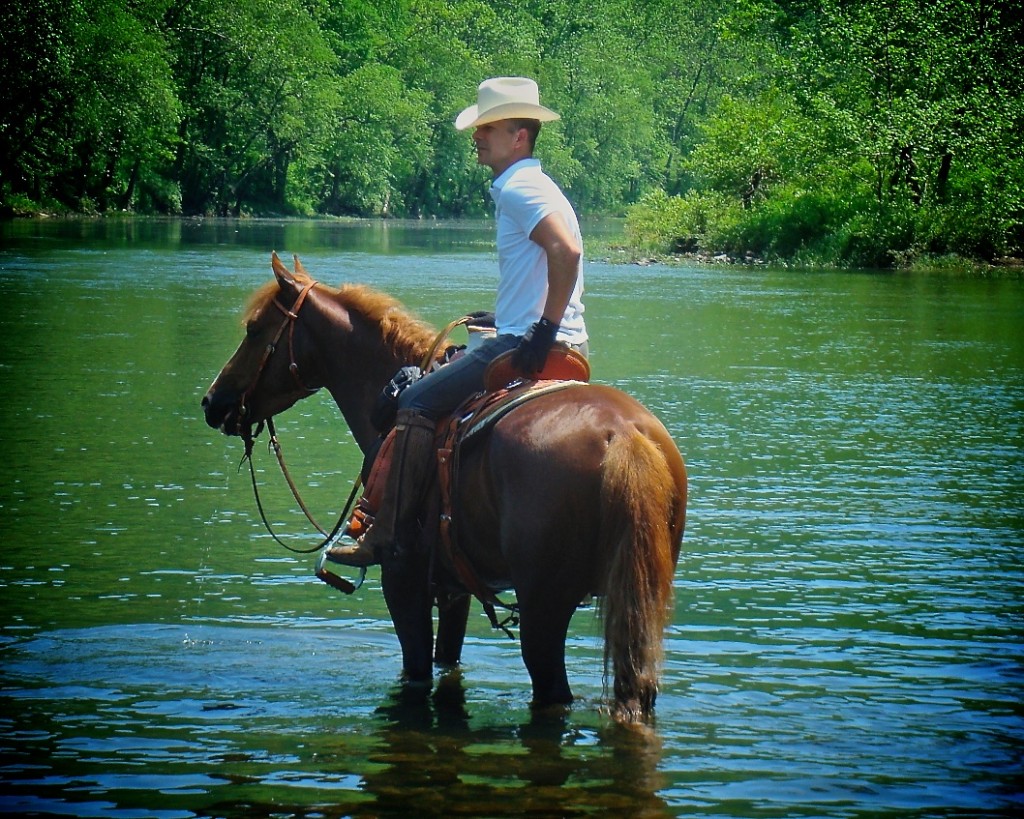Henry Fleming

The normal pirouette is a classical dressage movement requiring the horse’s forehand to travel around his hind quarters (as opposed to the reverse pirouette, which has the horse move his hindquarters around his forehand; and the more advanced centered pirouette which has the forehand and?hindquarters rotating around the central axis of the horse – less impressive to watch – and always mistaken as a mistake by onlookers – it’s the more difficult from an academic standpoint).
The dressage version of the movement is controlled and precise, implies for a slight bend to the inside, and may be performed at the walk, piaffe, or canter. ?In the dressage version, contact, rhythm, collection, and speed remain the same as the gait preceding it – there is no change in the frame, posture, or profile of the horse. ?Though the horse may pivot on the inside hind, more often, the inside hind traces a small circle the size of a dinner plate.
The “spin” refers to the similar pirouette-type movement performed in the context of American Western-style stock equitation. ?What the “spin” gives up in the appearance of control and precision, it gains in speed, making it one of the crowd-pleaser movements in reigning competition. ?The spin takes the pirouette to stylized extreme, with the horse more or less running – in either a rapid trotting or loping action (either is acceptable) – around the axis of his inside hind leg, upon which he pivots.
I’ve seen and read a number of approaches to teaching people how to “train” this exercise, and most are either confusing or misleading explanations. ?Others will get you there ‘kind of’, but they have you rather tricking the horse into it (e.g., by abandoning him as a reward when he accidentally pivots), which will become self-defeating in an academic progression – and while the result may be acceptable in the Reining arena, it won’t pass muster in the Dressage arena, nor suffice as an academic triumph in the manege. ?So, while teaching a proper pirouette can take you?to a spin, the vice versa is?does not work so well.
Here’s the main thing: ?if you’re going about it the right way, with an academic foundation, you’re not attempting to pirouette or spin a horse who has yet to be confirmed in the lessons of?the hand?and?the heel. ?Once he is, it’s no longer about teaching your horse to spin, it’s?rather about teaching?you to spin the horse.

If this sounds like a Matrix reference, it is. ?If it sounds like two ways of saying the same thing, it’s not. Or not really. ?Maybe it is. ?I need to re-watch the movie. ?In any event: ?popping a wheelie with your bike isn’t something your bike does, it’s something?you?do?with?the bike. ?The constraint is only your familiarity with the physics of the instrument itself – the bike is already?capable of it in the right hands.
Presuming you know how to ride a bike, once you understand how to do a little tiny wheelie, it is only a matter of fine tuning your own balance and coordination. ?So it is with spinning your horse -?sans the risk of falling over backwards.
Forewarning: ?Avoid “Trick” Training
Artificial means are good for wowing the ignorant and fooling ourselves.
– Nuno Oliveira to Michel Henriquet
What does Oliveira mean? ?He is distinguishing between making meaningful progress through academic development vs. meaningless “progress” using artificial methods, or, essentially, “trick” training. ?In this case, instead of the horse responding to the sensate language of the aids, which make him an extension of your very own mortal coil, and which should be able to effect, modify, or halt any given movement at any time, he?has otherwise been conditioned to respond to a one-off ‘queue’, triggering a routine. ?And thus the difference between dressage proper?and, say, dog training, which, theoretically, could?be brought to such?level of refinement, but, at least in my experience, never is.
A trick has no academic value. ?This is to say, you?may be?able to get your horse to do the thing visually, roughly anyway – but not as a result of the academic language you’ve learned and hopefully taught your horse to understand. ?As an example,?I can teach you to lift your right leg at my whim?by initially showing you a stick, and then hitting you in the right ankle with it. ?Hard. ?So it really smarts a bit. ?Unless you’re a masochist, the next time I show you the stick, you’re going to lift your right leg. ?And?Viola! ?I have just taught my human to stand on one leg. ?I call this the Sun Tzu method, and it is best saved for giddy concubines you need to become soldiers?in about ten minutes. ?It does not translate well to horses. ?At all.
Alternatively, relying upon our mutual understanding of a language I have hypothetically taught you – say, English (but it could be any code) – I could simply ask you to ‘lift your right leg’. ?Presuming you understand me, and having no reason not to, you will. ?Does it seem like the same outcome? ?From the perspective of onlookers, it may well seem the?same outcome. ?Initially. ?But?tomorrow, I’m going to want you to lift your left leg. And the next day, I’ll bring your arms into it. ?Though you might learn lifting your right leg pretty quickly via the tricky stick method, things go south?the moment I try to extent?the concept.
Of course, if you didn’t know a language beforehand, I would have needed to go to the trouble to teach English to you – and?that takes more time than simply assaulting your leg. ?But?once you know?English, I can ask you to lift your right leg, and you know what I mean. ?I can ask you to lift your left, and you know my meaning as well. ?I can further add to the instruction set without you becoming overly anxious about it, because you’re not going to get hit with a stick in any event – we’re just talking.
We can “trick train” a worthless, poorly formed ‘piaffe’ resembling two men in a horse costume by annoying the horse’s hind legs with whips until eventually he begins balancing on alternating diagonals, or in any event keeps moving?for fear of more annoyance (or in the case of the “dancing horses” phenomenon of Mexico, pain and surprise). ?Similarly, we can “trick train” a horse to “count” (nodding his head up and down) by pricking his withers with a safety pin every time we want him to nod. ?It is a simple reflex. ?In an identical manner, your doctor “teaches your knee to count” when you go in for a physical exam.
But quite aside from often being developed inhumanely, the “trick” simply has no enduring value beyond the isolated feat itself. ?It does not rely upon prior concepts, nor serve as an effective building block for future concepts. ?It?demonstrates no particular expertise on the part of the trainer, and the results are of no interest from an academic or artistic perspective. ?Just as the circus horse “counts”, while being as oblivious to?the notion of counting as your knee is, so too he can be made to “piaffe”, though he has no real concept of our desire for him to trot, only in place. ?He only knows?he?finds relief from annoyance by ‘keeping his hind legs moving’.
The very same may be said of a grand piaffe or passage whose brilliance is developed via?fetlock chains, weighted bell boots, etc. ?It’s not that all trick training, in and of itself, is inhumane or immoral (which it certainly can be, but not in all cases). ?It is that trick training is not extensible, and represents nothing of interest in the context of legitimate high school equitation. ?And thus the fundamental difference between what is historically termed “fantasy” training (i.e., ‘circus’), and academic?high school training.
A Better Point of Departure
When it comes to the spin, there simply is no reason to regress to tricking when you may simply convey it with everyday aids. ?(What? ?Yep! ?Just said that). ?Stop. ?The gap is simply your sense of feel and timing – and of course, these can be tricky. ?As it were.
Presuming your horse has at least the beginnings of an academic foundation (he is capable of direct, indirect, and neck reining, and is responsive to the hand and heel), all that remains?is for you to feel?the feeling of the horse pushing a bit more with his outside hind leg,?which necessarily vectors him more to the?inside?with his forehand,?however slightly.?Once you feel it, you’ll see how willing he is to let you manipulate it?rhythmically – increasing the inside angle to such an extent that he will pivot around his length on his inside hind leg. ?But it’s not the result of a trick. ?It is, rather, the accurate interpretation of (on the horse’s part) of coherent language and syntax. ?He is merely correctly responding to the sum of your aids at a given moment in time?- not executing an order “to spin” per se.
Before you can understand how to ask him – at the right time – to push a bit more with his outside hind than his inside (and ultimately effect a pirouette), you, of course, must understand how ‘pushing more with the outside hind’?feels?from the saddle.
Here is one means of finding it quickly and with certainty:
- Move your horse into an even-steven, relaxed but counted?or school walk in an open area with plenty of space on a straight line
- Pick a shoulder and pay attention to?- let’s say the left shoulder for now. ?Mentally tune into the visual rhythm of that shoulder moving back and forth
- Realize:?As this left shoulder moves forward,?your right calf simultaneously and?softly?”sinks” to the left, and then is gently pushed out again as his?left shoulder?comes back to you?(presuming your leg is relaxed and draped against the sides of the horse as it should be)
- Follow this motion and rhythm in your mind, until you distinctly feel the sinking of your calf. ?Now, with the most subtle pressure you can muster, you’re going to begin gently?resisting the force that pushes your calf ?out upon the left shoulder’s return for just an instant – as if your right leg was slightly behind the rhythm.? You will have the sensation you are almost?pushing the left shoulder forward with the timing of the pressure of your right calf.
- What will happen is that your horse will begin to slightly veer left each time your resist the tempo with your right leg.
- Prepare for the “aha!” moment: ?you will feel a slight increase in energy swinging you and his forehand to the left?with each reach of the left shoulder. ?What’s really happening – initially – is a reduction in push from the left hind, which you are effectively “braking” with each stride by encouraging him to lift the right?hind slightly prematurely, but let’s skip the quadrupedal physics for the time being).
- A little more pressure with your right calf at the right time, and you will notice a discernibly sharper cut to?the left with each stride, and the straight line you were on becomes?a large circle to the left, which you’ll find you may easily and quickly tighten at will via the timing of resistance with your right calf – to the extreme of a spin with a little practice.?
Men with an aversion to?having their sexual preferences called into question should stop here with the spin and buy a Stetson. ?In this savage day and age, we are at risk even being near a horse, sadly. ?Everyone else: ?keep refining. ?You should be able to take this draft movement to a proper pirouette within a few rides. ?Shazam. ?
To the work, then, cavaliers.
